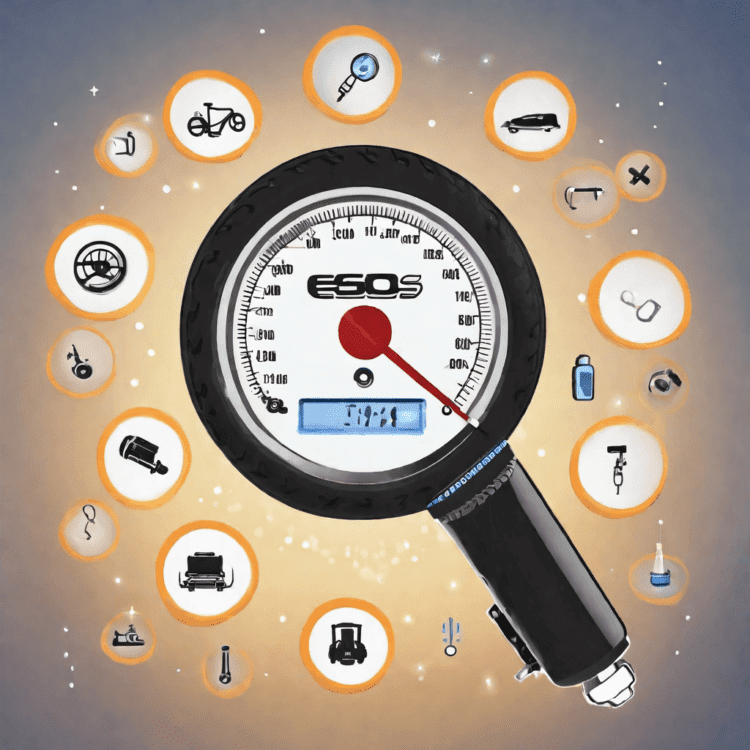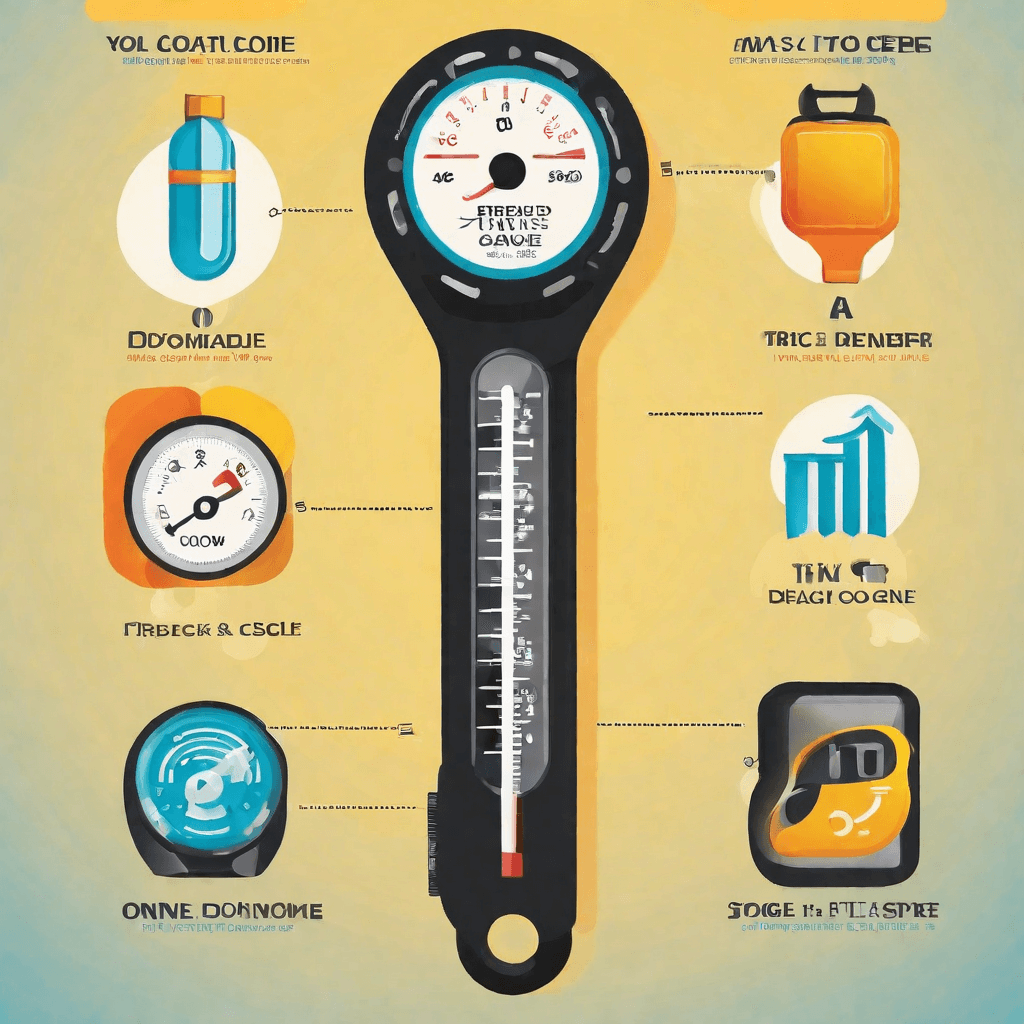Keeping your tires properly inflated is crucial for safe driving and maximizing your fuel efficiency. But without an accurate tire pressure gauge, you could be driving around unaware that your tire pressure is dangerously low.
That’s why having a high-quality low pressure tire gauge is essential. These specialized gauges are designed to provide precise PSI readings at the lower air pressure ranges used for passenger vehicles and light trucks.
In this blog post, we’ll share 10 expert-recommended tips and tricks for making the most of a low pressure tire gauge. You’ll learn how to choose the right gauge, use it properly, maintain accuracy over time, and troubleshoot common issues.
What is a Low Pressure Tire Gauge and Why is it Important?
A low pressure tire gauge is used to measure tire inflation pressures in the range of 5 to 35 PSI, which is the normal operating range for passenger vehicles and light truck tires.
Standard tire pressure gauges only reliably measure down to about 10 PSI. But low-pressure gauges use specialized internal components that allow them to accurately read the single-digit PSI levels that indicate an underinflated tire.
Driving on underinflated tires can lead to:
- Poor fuel economy
- Uneven tire wear
- Reduced handling and braking
- Overheating and blowouts
So having an accurate low-pressure gauge allows you to identify and correct low tire pressure before it becomes a serious safety issue.


Different Types of Low Pressure Tire Gauges
There are a few main types of low pressure tire gauges to choose from:
Dial gauges – The most common and inexpensive design. A mechanical gauge displays pressure readings via a needle on a round dial face. Requires good lighting to read precisely.
Digital gauges – Display tire pressure on an LCD screen. Easier to read exact PSI but requires batteries.
Auto-hold gauges – Holds the peak pressure reading automatically so you can remove the gauge and see the reading. No need to read while attached.
Lighted gauges – Illuminate the gauge face to make it easier to read in low light. Useful for nighttime checks.
Angled gauges – The pressure barrel is at a 45-degree angle for easier attachment to the valve stem. Helpful for tight spaces.
Each has pros and cons, so consider your needs and preferences when choosing a gauge type.
How to Use a Low Pressure Tire Gauge
Using a low pressure tire gauge correctly is important for accurate readings:
- Remove the valve stem cap and ensure the threads are clean and undamaged.
- Press the gauge straight onto the valve stem and hold it in place. Do not apply extra sideways pressure.
- Press the gauge firmly for several seconds until the reading stabilizes. Low pressure gauges need time to equalize and get an accurate low PSI reading.
- Note the stable reading, then release the pressure and remove the gauge.
- Refer to your vehicle’s recommended PSI level and inflate any underinflated tires as needed.
- Re-check pressure and make adjustments until reaching the target PSI.
- Replace the valve stem cap when finished to prevent dirt and moisture buildup.
Being patient and allowing time for an accurate reading is the key for proper use of a low pressure tire gauge.
How to Choose the Right Low Pressure Tire Gauge for You
Here are the main factors to consider when selecting a low pressure tire gauge:
- Accuracy – Precision within ±1 PSI is ideal for low pressure ranges. Look for gauges certified to ANSI B40.1 standards.
- Range – A high-quality gauge will reliably read from 5-60 PSI for the widest usefulness.
- Resolution – Look for 0.5 PSI or 0.1 PSI graduations for precise measurements.
- Ease of use – Consider display type, angled heads, auto hold, etc. Choose features that fit your needs.
- Durability – Metal and rubber construction lasts longer than plastic. Look for impact and drop resistance.
- Portability – Smaller gauges can fit in a pocket or glove box for on-the-go use. Keychain models are very portable.
Investing in a professional quality gauge from a reputable brand is worth the extra cost for years of reliable service.


Tips for Maintaining Your Low Pressure Tire Gauge
Proper maintenance keeps your low pressure tire gauge working accurately over the long run:
- Avoid dropping or banging the gauge to prevent internal sensor damage.
- Store gauges where they won’t encounter temperature extremes to prevent fluid leaks.
- Replace cracked or worn rubber hoses which can cause air leaks.
- Change batteries promptly when needed to maintain the digital display function.
- Periodically check gauge accuracy using a master pressure standard.
- Bleed moisture from the system periodically by depressing the chuck without being attached to a valve stem.
- Keep gauges in a protective case when not in use to prevent dust and dirt buildup.
- Use the gauge’s integrated air bleed valve to relieve pressure before storage.
Proper techniques and preventative maintenance give you years of reliable tire pressure measurements.
Common Mistakes to Avoid when Using a Low-Pressure Tire Gauge
It’s easy to accidentally get an incorrect reading if you don’t use the proper technique:
| Common Mistake | Impact |
|---|---|
| Not holding the gauge on the valve stem long enough | The reading will not stabilize at the true pressure |
| Touching the gauge dial or display while attached | Causes incorrect readings by altering the sensor position |
| Pushing the gauge on at an angle | Can damage the valve stem or seal, leading to leaks |
| Checking pressure when the tire is hot | Heat increases pressure – always measure cold tires |
| Not bleeding pressure before removing the gauge | Let air escape and provide false readings next time |
| Not tightening valve stem caps securely | Allows dirt and moisture to enter and damage the valve |
| Dropping the gauge or knocking it around | Can damage sensitive internal sensor mechanisms |
Avoid these common mistakes, and your low-pressure gauge will provide accurate, consistent tire pressure measurements.
How to Troubleshoot Problems with Your Low Pressure Tire Gauge
If your low-pressure readings seem inconsistent, try these tips to troubleshoot:
- Check batteries if it’s a digital model and replace if low.
- Make sure the air bleed valve is fully closed.
- Remove any dirt, debris, or moisture from the valve stem and gauge head.
- Listen for air leaks when the gauge is attached to the valve stem. Tighten connections or replace damaged parts.
- Compare readings to a known accurate gauge to check for inaccuracies.
- Gently exercise the needle on a mechanical dial gauge if sluggish.
- Return gauges under warranty to the manufacturer for sensor replacement if faulty.
- Consider replacing sealants, hoses, or internal components on older gauges.
With care and maintenance, a high-quality low-pressure gauge should provide accurate readings for 5 years or more. Contact the manufacturer if issues persist.
Benefits of Using a Low Pressure Tire Gauge
There are many good reasons to have a low-pressure tire gauge on hand:
- Identify underinflation before it becomes dangerously low
- Improved fuel efficiency from properly inflated tires
- Extend tire lifespan by reducing uneven wear
- Enhanced vehicle handling, braking, and stability
- Avoid blowouts and flat tires caused by underinflation
- Reduce the risk of accidents from compromised traction
- Lower repair costs by preventing tire and wheel damage
- Increased convenience checking pressure anytime
- Environmental benefits from improved fuel economy
- Provide peace of mind knowing your pressure is optimized
The small investment in a good low-pressure gauge pays dividends in safety, performance, and savings over the life of your vehicle.


How to Save Money by Using a Low-Pressure Tire Gauge
You can save real money in fuel and tire costs just by keeping your tires inflated properly:
- Underinflated tires reduce fuel economy significantly. Every 1 PSI drop in pressure decreases MPG by 0.4% on average.
- Properly inflated tires last longer before needing replacement. Under-inflated tires wear unevenly and must be replaced sooner.
- Preventative tire maintenance is cheaper than repairs from damage caused by low-pressure driving.
- Avoid the cost of roadside assistance or towing due to breakdowns from blowouts.
- Lower risk of accidents, liability claims, and higher insurance premiums.
- Reduce wasted money on fuel for reduced mileage caused by under-inflation.
- A quality low-pressure gauge often pays for itself within a year from the savings.
Checking your tire pressures monthly with an accurate low-pressure gauge saves you real money over the life of your vehicle.
Low Pressure Tire Gauges for Different Types of Vehicles
The optimal tire pressure range varies based on vehicle type and usage:
- Passenger cars: 25-35 PSI for standard models. 18-22 PSI for low-profile high-performance tires.
- Light Trucks: 25-35 PSI for solo driving. Reduce to 20-25 PSI when loaded or towing.
- ATVs: 3-6 PSI for trail riding. 8-12 PSI for pavement.
- Motorcycles: 25-40 PSI for street use. 15-25 PSI for off-road.
- Bicycles: 25-50 PSI for road bikes. 15-40 PSI for mountain bikes.
Always refer to your vehicle’s recommended pressure range when inflating. Owning a professional low-pressure gauge covers everything from bicycles to light trucks.
Conclusion
A low-pressure tire gauge is a vital tool for safe driving and maximizing the life of your tires. Follow these expert tips for choosing the right gauge and using it properly. A few minutes each month checking pressures can save you money and give you peace of mind on the road.
Frequently Asked Questions About Low Pressure Tire Gauges
What is the lowest pressure reading a low-pressure tire gauge can measure?
Most quality low-pressure gauges can accurately measure down to 5 PSI or less. Specialized ultra-low pressure gauges are available that can read as low as 1 or 2 PSI for very low-pressure applications.
How often should I check tire pressure with a gauge?
Experts recommend checking all tire pressures including the spare at least once per month. Check more frequently if you notice any underinflation symptoms like reduced fuel economy.
Can I add air to the tire directly through the low-pressure gauge?
No – low-pressure gauges are only designed to measure pressure, not fill tires. You must use a separate air compressor or compressed air source to inflate tires to the desired PSI.
How do I know when to replace a low-pressure tire gauge?
Replace gauges if they fail calibration tests, become damaged, or if readings are inconsistent. Also, replace analog gauges if the dial is cloudy or digits are hard to read.
Are digital or dial gauges better for low pressure?
Both types work effectively. Digital gauges are easier to get precise PSI readings but require batteries. Dial gauges have no batteries to change but can be harder to read accurately. Choose based on your needs and preferences.




